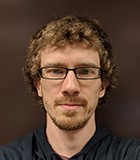 A team at the University of Michigan has recently completed a Foundation-funded project to develop a novel method for real-time 3D mapping of cavitation bubble clouds and the skull’s surface while applying histotripsy to the brain.
A team at the University of Michigan has recently completed a Foundation-funded project to develop a novel method for real-time 3D mapping of cavitation bubble clouds and the skull’s surface while applying histotripsy to the brain.
In “Acoustic Backscatter-based 3D Mapping of Cavitation and Skull Surface in Histotripsy Transcranial Applications,” investigator Jonathan Sukovich, PhD, and his colleagues used an acoustic cavitation emission – or backscatter – method to monitor the surface of the skull and to localize the bubble clouds generated during histotripsy treatments. This work provides the visualization that is necessary for ensuring that transcranial treatments can be safely delivered and eliminates the need for MRI-based treatment monitoring.
“These studies are important for advancing the possibility of a non-thermal approach to treating various brain diseases and expanding the treatment envelope,” said Matt Eames, PhD, the Foundation’s Director of External Awards.
Results from the study will soon be submitted for journal publication and will be accessible in the Foundation’s FocUS Archive.
